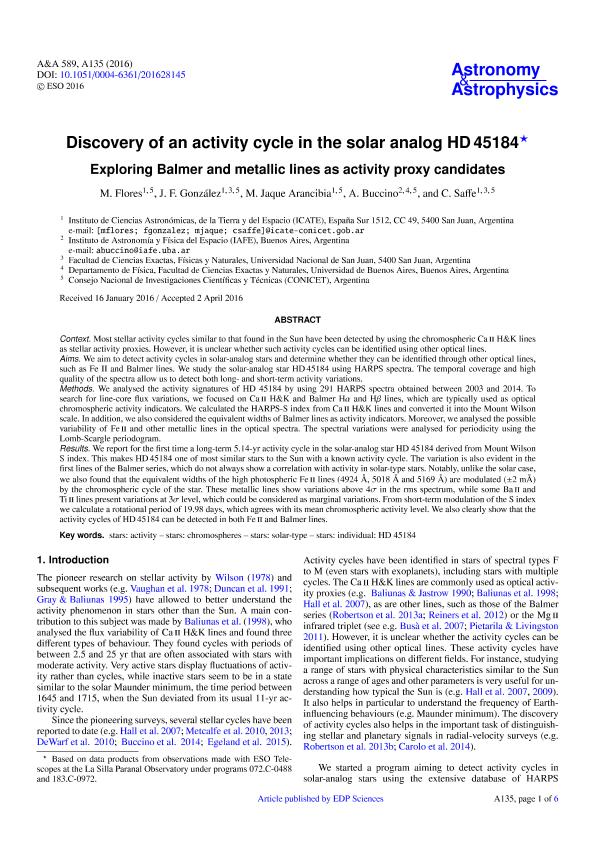Artículo
Discovery of an activity cycle in the solar-analog HD 45184. Exploring Balmer and metallic lines as activity proxy candidates
Flores Trivigno, Matias Gaston ; Gonzalez, Jorge Federico
; Gonzalez, Jorge Federico ; Jaque Arancibia, Marcelo Daniel
; Jaque Arancibia, Marcelo Daniel ; Buccino, Andrea Paola
; Buccino, Andrea Paola ; Saffe, Carlos
; Saffe, Carlos
 ; Gonzalez, Jorge Federico
; Gonzalez, Jorge Federico ; Jaque Arancibia, Marcelo Daniel
; Jaque Arancibia, Marcelo Daniel ; Buccino, Andrea Paola
; Buccino, Andrea Paola ; Saffe, Carlos
; Saffe, Carlos
Fecha de publicación:
05/2016
Editorial:
EDP Sciences
Revista:
Astronomy and Astrophysics
ISSN:
0004-6361
Idioma:
Inglés
Tipo de recurso:
Artículo publicado
Clasificación temática:
Resumen
Context. Most stellar activity cycles similar to that found in the Sun have been detected by using the chromospheric Ca ii H&K lines as stellar activity proxies. However, it is unclear whether such activity cycles can be identified using other optical lines. Aims. We aim to detect activity cycles in solar-analog stars and determine whether they can be identified through other optical lines, such as Fe II and Balmer lines. We study the solar-analog star HD 45184 using HARPS spectra. The temporal coverage and high quality of the spectra allow us to detect both long- and short-term activity variations. Methods. We analysed the activity signatures of HD 45184 by using 291 HARPS spectra obtained between 2003 and 2014. To
search for line-core flux variations, we focused on Ca ii H&K and Balmer Hα and Hβ lines, which are typically used as optical chromospheric activity indicators. We calculated the HARPS-S index from Ca ii H&K lines and converted it into the Mount Wilson scale. In addition, we also considered the equivalent widths of Balmer lines as activity indicators. Moreover, we analysed the possible variability of Fe ii and other metallic lines in the optical spectra. The spectral variations were analysed for periodicity using the Lomb-Scargle periodogram. Results. We report for the first time a long-term 5.14-yr activity cycle in the solar-analog star HD 45184 derived from Mount Wilson S index. This makes HD 45184 one of most similar stars to the Sun with a known activity cycle. The variation is also evident in the first lines of the Balmer series, which do not always show a correlation with activity in solar-type stars. Notably, unlike the solar case, we also found that the equivalent widths of the high photospheric Fe ii lines (4924 Å, 5018 Å and 5169 Å) are modulated (±2 mÅ)
by the chromospheric cycle of the star. These metallic lines show variations above 4σ in the rms spectrum, while some Ba ii and Ti ii lines present variations at 3σ level, which could be considered as marginal variations. From short-term modulation of the S index we calculate a rotational period of 19.98 days, which agrees with its mean chromospheric activity level. We also clearly show that the
activity cycles of HD 45184 can be detected in both Fe ii and Balmer lines.
Archivos asociados
Licencia
Identificadores
Colecciones
Articulos(IAFE)
Articulos de INST.DE ASTRONOMIA Y FISICA DEL ESPACIO(I)
Articulos de INST.DE ASTRONOMIA Y FISICA DEL ESPACIO(I)
Citación
Flores Trivigno, Matias Gaston; Gonzalez, Jorge Federico; Jaque Arancibia, Marcelo Daniel; Buccino, Andrea Paola; Saffe, Carlos; Discovery of an activity cycle in the solar-analog HD 45184. Exploring Balmer and metallic lines as activity proxy candidates; EDP Sciences; Astronomy and Astrophysics; 589; A135; 5-2016; 1-6
Compartir
Altmétricas



